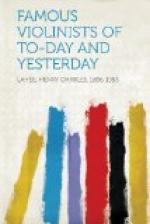The Kneisel Quartet was organised in 1885, the year in which Mr. Franz Kneisel accepted the position of concert-master to the Boston Symphony Orchestra. Mr. Henry L. Higginson invited him at the same time to organise a quartet, and a series of concerts was given that season in Chickering Hall. While the excellence of the quartet was apparent from the start, there were comparatively few people in Boston who took much interest in chamber music, and the audiences were, as a rule, small. Year by year they have increased, and for the past few years it has been necessary to give the concerts in Association Hall, which has a seating capacity about twice as large as that of the original hall.
The second violin is Mr. Otto Roth,[2] a native of Vienna, who played for three years under the baton of Hans Richter, and came to Boston to play first violin in the Symphony Orchestra.
[Footnote 2: Mr. Roth retired from the quartet in 1899 and his place was filled by Mr. Karl Ondricek.]
Mr. Louis Svecenski, an excellent artist, who studied in the Vienna Conservatory, under Hellmesberger and Gruen, plays the viola, and the ’cellist is Alwyn Schroeder, an artist, who had achieved a high reputation as a ’cello virtuoso, before he came to America.
After a few years the Kneisel Quartet began to appear in other cities, and now gives regular series of subscription concerts in New York, Washington, Baltimore, Hartford, and Worcester, also Harvard, Yale, and Princeton Universities, besides occasional performances in more remote cities. In 1896 the quartet had given over eight hundred concerts since its formation.
[Illustration: FRANZ KNEISEL]
At the end of the Symphony season in Boston, in 1896, the Kneisel Quartet made a visit to London and gave several concerts. In London it was obliged to stand comparison with the finest quartets in existence. The Joachim Quartet and the Bohemian Quartet gave concerts the same season, but the unanimous verdict was to the effect that none could equal the Kneisel Quartet in absolute ensemble and perfection of detail. While the Bohemian Quartet played with a great deal of abandon and enthusiasm, and the Joachim Quartet contained players of a greater reputation in Europe, yet the Kneisel Quartet simply confirmed the reputation it had acquired in America. “It would, indeed, be impossible to conceive greater perfection in the matter of ensemble, precision, delicacy, and all the qualities requisite for the proper interpretation of chamber music.”
In the spring of 1899 the Kneisel Quartet made an extended tour in America, and found the musical condition of the great cities in the United States, as evidenced by the appreciation of music, fully equal to that of the European centres. Brahms and Beethoven were played in Denver and in San Francisco to audiences who were fully equal to the enjoyment of the highest class of music, and everywhere the quartet was greeted with enthusiasm.




